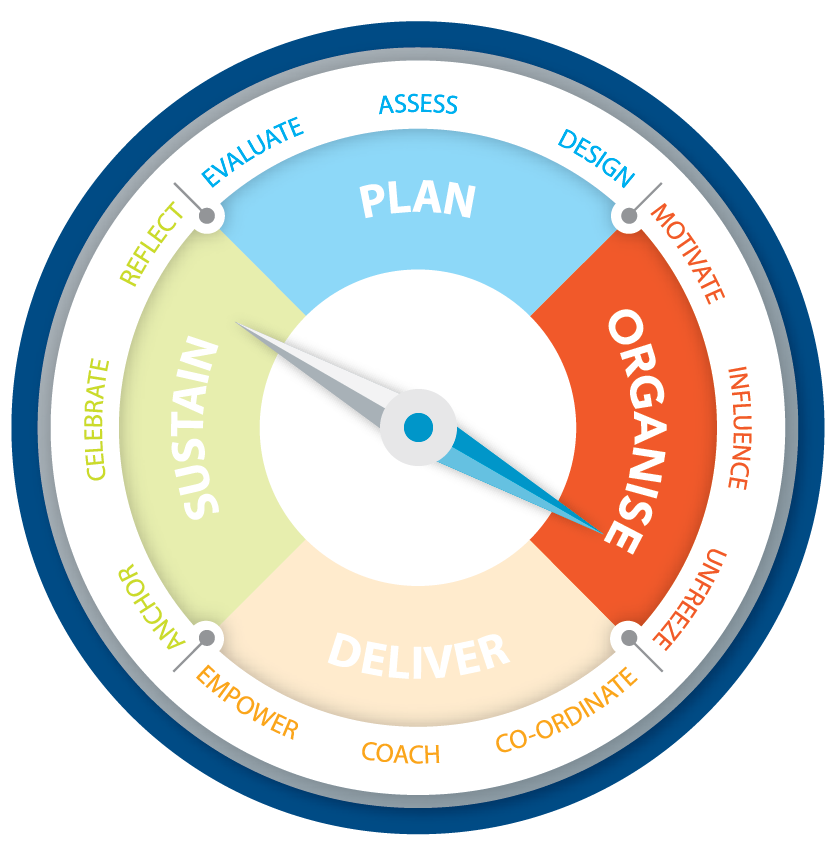
There are several reasons why people resist change:
Resistance to change is indicated by behaviours that include:
Once you have identified resistance, you need to manage it immediately. Key actions that you can take to overcome resistance are:
To increase acceptance of change, leaders can create a sense of urgency which helps generate action and build momentum. You can do this by:
Leaders need to lead with a sense of urgency. Consider incorporating these initiatives into your everyday role:
One of the ways to engage team members is to encourage them to have a voice on the how the change is being delivered. Get them to set the agenda and plan actions. Team members may look at challenges from a different perspective than leaders, and they may have a more creative or innovative approach on ways to embed the change within their team. Ask them.....
When undertaking a brainstorming session with a team, create a structure that allows for the development of ideas, whilst at the same time encouraging creative thinking. You can use DeBono's Seven Hats to work through your ideas and ensure everything is on the table.
- Lack of understanding - people do not see a reason for the change, or are not aware of the benefits.
- Loss of control - people feel that things are being done ‘to’ them.
- Lack of trust - people do not trust those that are proposing the change and often attribute negative motives.
- Change fatigue - people feel that there has been too much change already and they do not have the capacity to take on more change.
- Economic loss - people feel that their pay and/or benefits may be reduced or that their employment will suffer.
- Loss of security or surety - people feel that the new situation will result in a risk to their employment, their status, or their confidence in their ability to do the job.
- Fear of the unknown is the strongest emotional reaction in a change environment.
Behavioural indicators of resistance
Resistance to change is indicated by behaviours that include:
- Verbal challenges or criticisms of the change (often repeatedly).
- Starting of rumours or spreading misinformed opinion or dis-information.
- Building a coalition to resist and oppose the change.
- Lacking commitment to participate in related activities (absenting themselves with excuses).
- Failing to adopt the behavioural change and persisting with old habits.
- Actively interfering with the implementation or people endeavouring to co-operate.
Active ways to minimise resistance
Once you have identified resistance, you need to manage it immediately. Key actions that you can take to overcome resistance are:
- Communicate openly - regular and frequent communication can reduce fear, prevent rumours, gain buy-in and build trust.
- Engage team members - encourage team members to participate in the change by attending information sessions, becoming a change champion or leading agenda items in team meetings.
- Coaching - supportive coaching discussions can help to shift the focus from feelings of anger and frustration to a focus on building capability to effectively adapt to the change.
- Training - use specific practice and repetition of new behaviours (under supervision) to build the new "habit".
- Recognition - recognise team members who embrace change or put in a committed effort during implementation. It is important to also recognise team members who help their peers adjust to change.
- Identify miscreants and non-conforming behaviours and call out the unsatisfactory behaviours.
Active ways to minimise resistance
“I have been impressed with the urgency of doing. Knowing is not enough; we must apply.
Being willing is not enough; we must do.” (Leonardo da Vinci)
Being willing is not enough; we must do.” (Leonardo da Vinci)
To increase acceptance of change, leaders can create a sense of urgency which helps generate action and build momentum. You can do this by:
- Discussing the major change drivers including potential crises or major opportunities.
- Selling the value and benefits in order to win their ‘hearts and minds’.
- Disturbing the status quo and explaining the consequences of not acting now.
- Positioning the planned change in relation to primary stakeholders or external clients.
- Sharing data, information and threats that supports the need for change.
- Eliminate non urgent tasks to prioritise change (Refer to 'delegation' section).
- Remove obstacles and bureaucratic processes.
- Respond quickly to tasks, emails and phone messages.
- Make timely decisions and avoid procrastination.
- Keep meetings on time with a set agenda.
- Set deadlines for actions and hold people to account for them.
Brainstorm innovation and initiatives
One of the ways to engage team members is to encourage them to have a voice on the how the change is being delivered. Get them to set the agenda and plan actions. Team members may look at challenges from a different perspective than leaders, and they may have a more creative or innovative approach on ways to embed the change within their team. Ask them.....
When undertaking a brainstorming session with a team, create a structure that allows for the development of ideas, whilst at the same time encouraging creative thinking. You can use DeBono's Seven Hats to work through your ideas and ensure everything is on the table.
|
|
It is important not to challenge the ideas as they are presented during the brainstorm, as this
will restrict other team members’ creativeness and you will limit the responses that you receive. Only when all the
ideas are given should you discuss the pros and cons of each suggestion.
|
| ©1999 - 2020 Sandar Management Services Pty Ltd |
